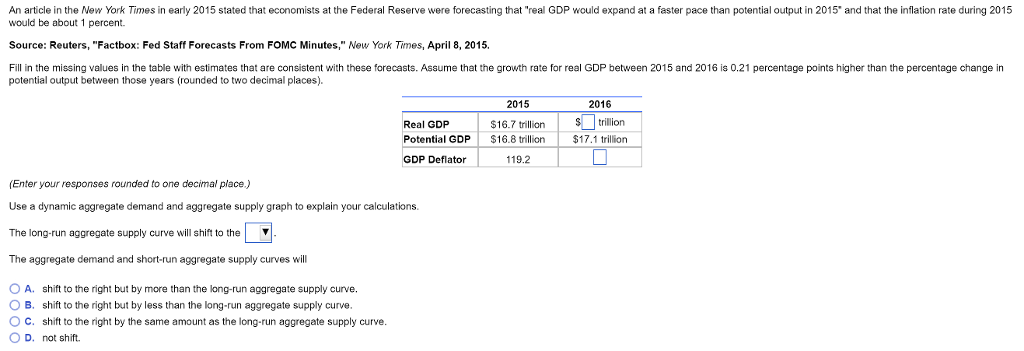An article in the New York Times in early 2015 stated that economists at the Federal Reserve were forecasting that "real GDP would expand at a faster pace than potential output in 2015 and that the inflation rate during 2015 would be about 1 percent. Source: Reuters, "Factbox: Fed Staff Forecasts From FOMC Minutes," New York Times, April 8, 2015. Fill in the missing values in the table with estimates that are consistent with these forecasts. Assume that the growth rate for real GDP between 2015 and 2016 is 0.21 percentage points higher than the percentage change in potential output between those years (rounded to two decimal places). Real GDP Potential GDP GDP Deflator (Enter your responses rounded to one decimal place.) Use a dynamic aggregate demand and aggregate supply graph to explain your calculations. The long-run aggregate supply curve will shift to the The aggregate demand and short-run aggregate supply curves will OA. shift to the right but by more than the long-run aggregate supply curve. OB. shift to the right but by less than the long-run aggregate supply curve. OC. shift to the right by the same amount as the long-run aggregate supply curve. O D. not shift. 2015 $16.7 trillion $16.8 trillion 119.2 2016 $ trillion $17.1 trillion 0
An article in the New York Times in early 2015 stated that economists at the Federal Reserve were forecasting that "real GDP would expand at a faster pace than potential output in 2015 and that the inflation rate during 2015 would be about 1 percent. Source: Reuters, "Factbox: Fed Staff Forecasts From FOMC Minutes," New York Times, April 8, 2015. Fill in the missing values in the table with estimates that are consistent with these forecasts. Assume that the growth rate for real GDP between 2015 and 2016 is 0.21 percentage points higher than the percentage change in potential output between those years (rounded to two decimal places). Real GDP Potential GDP GDP Deflator (Enter your responses rounded to one decimal place.) Use a dynamic aggregate demand and aggregate supply graph to explain your calculations. The long-run aggregate supply curve will shift to the The aggregate demand and short-run aggregate supply curves will OA. shift to the right but by more than the long-run aggregate supply curve. OB. shift to the right but by less than the long-run aggregate supply curve. OC. shift to the right by the same amount as the long-run aggregate supply curve. O D. not shift. 2015 $16.7 trillion $16.8 trillion 119.2 2016 $ trillion $17.1 trillion 0
Economics (MindTap Course List)
13th Edition
ISBN:9781337617383
Author:Roger A. Arnold
Publisher:Roger A. Arnold
Chapter14: Money And The Economy
Section: Chapter Questions
Problem 8QP
Related questions
Question
Sub : Economics
Pls answerin 15 mins.Dnt CHATGPT.I ll upvote. Thank You

Transcribed Image Text:An article in the New York Times in early 2015 stated that economists at the Federal Reserve were forecasting that "real GDP would expand at a faster pace than potential output in 2015 and that the inflation rate during 2015
would be about 1 percent.
Source: Reuters, "Factbox: Fed Staff Forecasts From FOMC Minutes," New York Times, April 8, 2015.
Fill in the missing values in the table with estimates that are consistent with these forecasts. Assume that the growth rate for real GDP between 2015 and 2016 is 0.21 percentage points higher than the percentage change in
potential output between those years (rounded to two decimal places).
Real GDP
Potential GDP
GDP Deflator
(Enter your responses rounded to one decimal place.)
Use a dynamic aggregate demand and aggregate supply graph to explain your calculations.
The long-run aggregate supply curve will shift to the
The aggregate demand and short-run aggregate supply curves will
A. shift to the right but by more than the long-run aggregate supply curve.
OB. shift to the right but by less than the long-run aggregate supply curve.
OC. shift to the right by the same amount as the long-run aggregate supply curve.
OD. not shift.
2015
$16.7 trillion
$16.8 trillion
119.2
2016
$ trillion
$17.1 trillion
||

Transcribed Image Text:Furthermore, the demand curve will shift to the right by
The new short-run equilibrium will be where
than the short-run aggregate supply curve.
O A. the new aggregate demand curve intersects the new short-run aggregate supply curve, on the new long-run aggregate supply curve.
O B. the new aggregate demand curve intersects the new short-run aggregate supply curve, to the right of the new long-run aggregate supply curve.
O c. the new aggregate demand curve intersects the new short-run aggregate supply curve, on the original long-run aggregate supply curve.
O D. the new aggregate demand curve intersects the new short-run aggregate supply curve, to the left of the new long-run aggregate supply curve.
Expert Solution
This question has been solved!
Explore an expertly crafted, step-by-step solution for a thorough understanding of key concepts.
This is a popular solution!
Trending now
This is a popular solution!
Step by step
Solved in 3 steps

Knowledge Booster
Learn more about
Need a deep-dive on the concept behind this application? Look no further. Learn more about this topic, economics and related others by exploring similar questions and additional content below.Recommended textbooks for you

Economics (MindTap Course List)
Economics
ISBN:
9781337617383
Author:
Roger A. Arnold
Publisher:
Cengage Learning



Economics (MindTap Course List)
Economics
ISBN:
9781337617383
Author:
Roger A. Arnold
Publisher:
Cengage Learning

